[Retracted] University Media Content Detection and Classification Based on Information Fusion Algorithm
Abstract
In order to further solve the problems in promoting the classification of media content in colleges and universities, the effective analysis and understanding of multimedia data content can be better realized based on the characteristics of multimedia data in colleges and universities, combining with the characteristics of rich information, large differences in performance, and large amount of large-scale data. This essay mainly introduces the technology of university media content detection and classification based on information fusion algorithm and focuses on the application of university multimedia content detection, analysis, and understanding, to explore the image discrimination auxiliary attribute feature learning and content association prediction and classification. A benchmark model for media content detection and classification is constructed. Through the model test, it is found that the F1 value of the model is more than 70%, the check rate is more than 80%, and the recall rate is more than 50%. On this basis, a content detection system based on campus network is constructed.
1. Introduction
With the rapid development of the Internet, the influence of the Internet on the contemporary people is increasing. Especially for teenagers, the Internet has brought great influence on their thoughts and life. For example, websites such as violence, pornography, and gambling under online media are contacted and browsed by more and more teenage users, which is not conducive to the establishment of correct values among teenagers. For colleges and universities, in the context of the rapid development of the Internet, how to effectively monitor the campus media network information content and timely find the bad information and content in the college media network is a problem that must be paid attention to in the field of education today [1]. The rapid development of the network makes the development of the campus network is also rising rapidly. Campus media network has a wide range of users, including office users, teaching users, and students. How to better realize the detection and classification of media content with the help of technical optimization under the condition of multiple users is a problem that universities must attach importance to [2]. Therefore, this essay tries to use information fusion algorithm to better realize the detection and scientific classification of media content.
2. Literature Review
Shu et al. proposed a new weakly supervised depth matrix decomposition algorithm for weakly supervised label association images provided by users to learn the potential representation of data [3]. In this method, the latent image representation and markup representation hidden in the latent subspace are revealed through the collaborative study of weakly supervised markup information, visual structure, and semantic structure. It can naturally embed new images into subspaces, combine semantic and visual structures, and learn idiomatic subspaces without overfitting noise, incomplete or subjective labels. In addition, the method can deal with noisy, incomplete or subjective labels and noisy or redundant visual features. Xu et al. proposed the introduction of attribute-based classification, in which objects are identified based on high-level descriptions of semantic attributes (such as object color or shape). The system classifies objects from a list of high-level semantically meaningful attributes called attributes. Attributes act as an intermediate layer in the classifier cascade, enabling the system to identify object classes that do not see a single training example [4]. Because the recognition of each attribute is beyond the current specific learning task, attribute classifiers can be independently prelearned, for example, from existing image datasets unrelated to the current task, new classes can then be detected based on their attribute representation without the need for a new training phase. Representation-based semantic attributes can describe visual content well and improve the performance of visual understanding. Therefore, it is very important to explore the semantic properties of visual understanding, especially fine-grained visual understanding. Plaza-Del-Arco et al. proposed an interactive method to obtain the important and distinguishing attributes of manual continuous annotation. Local attributes with distinguishing and semantic meaning are discovered from image data sets using only fine-grained category labels and object boundary box annotations [5]. A potential conditional random field model is used to discover candidate attributes that are detectable and differentiated, and then a recommendation system is used to select attributes that may have semantic significance. Human interactions are used to provide semantic names for discovered properties. Design features that we learn based on known attributes are not necessarily significant and can automatically and efficiently construct visual recognition to distinguish unknown categories. Alsagri and Ykhlef believed that the description model required fine-grained image information, so they used the object detection model to segment the subgraph in the image and transform the subgraph into local features, so as to provide more detailed image features [6]. Verdoliva proposed fine-tuning the neural network by using attribute triplet loss and proposed a feature generation learning framework based on CNN to solve the generalized zero-sample learning task [7].
3. Principles of Content-Based Audio Classification and Retrieval
3.1. System Framework
Content-based audio classification and retrieval system (CBRA) is a kind of information service system between information user and audio database. Figure 1 shows the system framework of THE CBRA system [8]. In audio retrieval, we need to go through the key steps of feature extraction, audio segmentation, audio recognition, and classification and index retrieval. The system includes two parts: audio database generation module and user query and browse module.
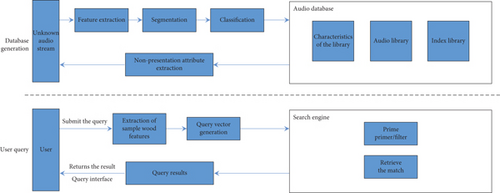
The audio data is clustered by feature, and the clustering information is packed into the part of clustering parameter library.
3.1.1. Extraction of Nonpresentation Attribute Information
Used to deal with the user’s regular query, this module extracts two major attributes: general file attributes, including the full file name, file size, editing time; and audio encoding attributes, including encoding format, playback time, number of channels, sampling rate, and sampling bits.
3.1.2. Feature Extraction
Feature extraction is one of the core functions of the system [9]. Every time a piece of audio data is added to the audio library, its audio features should be extracted. Analyze the value of each feature, so that it can be segmented and classified and then added into the feature database. Feature extraction is also commonly used in audio retrieval, and the query feature vector is determined by combining attribute values. For example, when a user submits a sample, its features must be extracted before similarity calculation can be carried out.
3.1.3. Audio Segmentation
Using the corresponding audio features in the feature database, the current long-time audio stream is segmented so that the segmented audio segment contains a single type.
3.1.4. Audio Classification
Audio Classification is the key functions of audio retrieval system. The segmented audio segments are automatically classified and classified into different predefined semantic classes. In this step, the segmented audio physical units can be roughly divided [10]. For example, the segmented audio can be classified as mute, music, voice, environment sound, etc.; and an event or a person can also be finely classified, such as “explosion” event and “speech” event.
3.2. Audio Feature Analysis and Expression
3.2.1. Audio Signal Digitization and Preprocessing
Audio signal is a one-dimensional analog signal with continuous change of time and amplitude. Although its forms are various, the first step of processing with modern information technology is digital processing and preprocessing of the signal. The digital processing of audio signal is mainly to process it and turn it into digital signal with discrete time and amplitude: generally including amplification and gain control, antialiasing filtering, sampling, A/D conversion, and coding (generally PCM code). As shown in Figure 2, the digitized audio signal is actually a time-varying signal [11]. Preprocessing generally includes endpoint detection, preweighting, and frame adding window.

where e(n) is called quantization error or quantization noise, is the quantized sampling value, namely, the quantizer output value, and x(n) is the unquantized sampling value, namely, the quantizer input value.
3.2.2. Analysis and Expression of Audio Features
where Em represents the average energy of the mth audio frame signal; x(n) represents the value of the nth sampling point in the mth audio frame; w(n) is the window function.
Zm represents the short-time zero crossing rate of the mth audio frame; x(n) represents the value of the nth sampling point in the mth audio frame; w(n) is the window function.
The autocorrelation function provides a way to obtain the period of a periodic signal: its autocorrelation function can reach its maximum value on an integer multiple of the periodicity of the periodic signal. That is, the period can be estimated from the position of the first maximum value of the autocorrelation function without considering the start time of the signal [15].
Obviously, if x(n) is periodic within the window value range, then Fn(k) will have a minimum value at (k = 0, Np, 2Np, ⋯). In contrast to Rn(k), Fn(k) has valleys rather than peaks at various integral multiples of the period.
where fs is sampling frequency.
3.3. Features of Content-Based Audio Retrieval
- (1)
Extracting Information Clues from Media Content. Content-based retrieval breaks through the limitation of traditional keyword-based retrieval. Audio is retrieved according to the inherent characteristics of audio itself rather than the external attributes or keywords manually marked, making the retrieval closer to media objects [18]. Its core idea is to analyze the structure and semantics of audio through certain computer processing and establish their structured organization and index, so that the “disorderly” audio becomes “orderly,” which is conducive to users’ retrieval and browsing
- (2)
Similarity Retrieval. This is an important feature of content-based audio retrieval. For audio, the content is imprecise, and the sensory and expressive inconsistencies greatly increase the difficulty of processing. Therefore, content-based audio classification can only be a kind of similarity classification, abandoning the traditional exact matching and avoiding the uncertainty caused by the traditional retrieval methods, but the results often appear false detection and omission
- (3)
Fast Retrieval of Large Databases (Sets). For a large number, a wide variety of multimedia databases. It can realize the rapid retrieval and positioning of multimedia information
- (4)
As a multimedia technology, it has strong interactivity, that is, users can participate in the retrieval process [19]
4. Context Information Fusion Algorithm in Scene Semantic Parsing
The basic idea of this method is shown in Figure 3: this essay tries to introduce a sampling module to reduce the spatial dimension of the key matrix and value matrix. The method proposed in this essay has achieved excellent performance on three challenging semantic segmentation datasets Cityscapes, ADE20K, and PASCAL Context [20]. In terms of time and space efficiency, APNB runs about 6 times faster on GPU than NB for 256 × 128 input feature map and occupies about 28 times less GPU memory space.
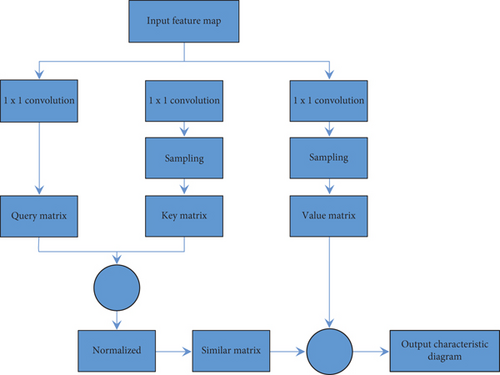
Wo is also a 1 × 1 convolution layer, which mainly plays two roles. On the one hand, it can restore the number of channels represented by the feature O from to C to keep consistent with the input feature X. On the other hand, the convolution layer Wo can be used as a weighting factor to adjust the importance of context feature O and input feature X to the final output feature graph Y.
5. Design of Content Detection and Analysis System of University Campus Network Based on Network Public Opinion
5.1. System Architecture Design
The purpose of the campus network public opinion detection and monitoring work is to detect and deal with public opinion in time. Therefore, for the monitoring of public opinion on related websites, it is necessary to build a complete set of internal monitoring mechanism for public opinion information in colleges and universities. In the era of big data, the monitoring of public opinion in schools must be supported by a strong data collection and analysis technology platform. The system mainly consists of processing system, analysis system, collection system, and report system. Only with the cooperation of each module can public opinion retrieval, event trend analysis, and corpus collection be completed. Here, corpus collection focuses on news websites and media with strong interactivity with a large number of netizens’ comments [23]. For the collection of the above media public opinion corpus, it can use metasearch method to obtain the latest information, can use event tracking and trend analysis technology to grasp the topic emotion direction, and can take the form of graphs and tables to show the results of public opinion analysis. Figure 4 shows the system technical architecture.
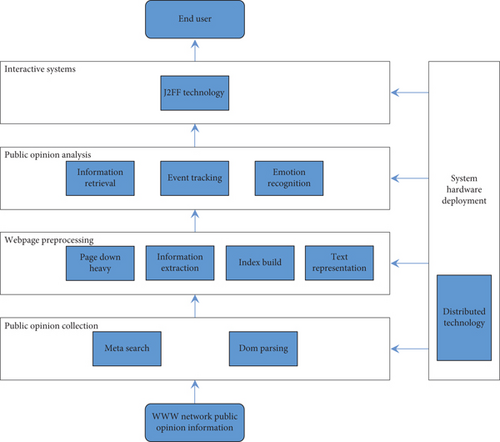
5.2. System Case Test
For school network public opinion detection, the relevant monitoring content can also be divided into three different words, such as subject, object, and emotional tendency, and then the words are dynamically combined and matched to generate relevant public opinion topics, and then use professional big data to monitor analytical technology, multidimensional collection of relevant information. Different users, its needs reflect personalized characteristics. In order to meet the demand, the retrieval function needs to be further improved. The top layer mainly uses the content in Figure 5, which mainly includes information search, information statistics, information collection, information analysis and classification, data processing, data storage to the archives, and unified system management.
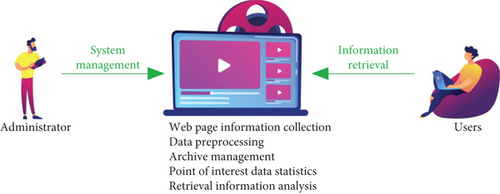
5.2.1. Subsystem Function Use Case Analysis
Figure 6 shows web page information collection. The web crawler technology is applied to obtain more accurate web page information, which can effectively eliminate the information irrelevant to their own needs, so that the content of the database can be updated in time.
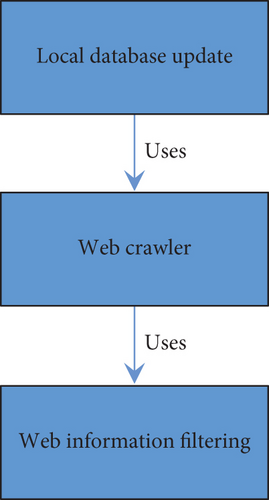
Generally collected information comes from the Internet, but there is no way to directly collect and extract information on the Internet. Even personalized search cannot be implemented [24]. Therefore, it is necessary to conduct a detailed investigation on the user’s own preferences and background and divide the browsing scope of the content of the web terminal. In combination with the specific situation of public opinion analysis, the scope of information collection in the web terminal is obtained. For details, please refer to Table 1.
| Range of collection | A basic description |
|---|---|
| Key work of colleges and universities | The main work of the college is to reflect the information of mainstream media such as the official website of the college, as well as the mainstream public opinion of netizens and the corresponding comments. |
| College policies and measures | National college reforms and policies implemented as well as online public opinion in mainstream media; different environment, knowledge, and background of users produce different network public opinion praise or criticism. |
| Significant events | The events with great influence in a certain period of time, as well as the information comments and netizens’ release. |
| The emergency | Large-scale traumatic emergencies and the information dissemination and evaluation caused by them. |
| The people’s livelihood related | Major application distribution platforms release, comment, and spread the vital interests of people’s livelihood, forming a large number of online public opinion information resources. |
In the supervision of online public opinion, the following two functional requirements should be realized: (1) mining public opinion information; (2) collect public opinion content. For end users, it can configure public opinion collection services in the field. B/S method is adopted, and it can have the function of follow-up tracking of public opinion information and emotion discovery. The following Figure 7 is the use case diagram of the public opinion monitoring system.
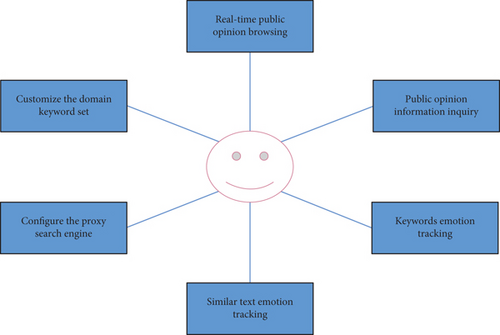
5.2.2. System Database Design
According to the above business operating procedures, database design concepts, and system module construction, the mining and analysis of university campus media can be realized. This database needs to contain the following Tables 2–10.
| The column name | The data type | Explanatory notes |
|---|---|---|
| Id | Int | The table’s primary key |
| URL | Varchar (200) | The URL of the opinion article |
| Source | Varchar (200) | The source of opinion articles |
| Theme | Varchar (200) | Subject of public opinion |
| Author | Varchar (200) | Author of public opinion |
| Content | Text | The body of public opinion |
| Date | DateTime | Publication time of public opinion |
| Comment_num | Int | Comment number |
| Link_num | Int | Forwarding number |
| The column name | The data type | Explanatory notes |
|---|---|---|
| Id | Int | The table’s primary key |
| URL | Varchar (200) | The URL of the opinion article |
| Source | Varchar (200) | The source of opinion articles |
| Theme | Varchar (200) | Subject of public opinion |
| Author | Varchar (200) | Author of public opinion |
| Date | DateTime | Publication time of public opinion |
| Keyword | Varchar (200) | Key words of public opinion |
| Comment_num | Int | Comment number |
| Link_num | Int | Forwarding number |
| Element | Varchar (200) | Elements of public opinion |
| IsNegative | Double | Negative or not |
| IsPublk | Int | Whether the public opinion |
| Class_media | Varchar (200) | Classified information |
| The column name | The data type | Explanatory notes |
|---|---|---|
| Id | Int | The table’s primary key |
| Keyword | Varchar (200) | Keywords |
| Class_media | Varchar (200) | Category of belonging |
| The column name | The data type | Explanatory notes |
|---|---|---|
| Id | Int | The table’s primary key |
| Keyword | Varchar (200) | Keywords |
| The column name | The data type | Explanatory notes |
|---|---|---|
| Id | Int | The table’s primary key |
| Name | Varchar (200) | Category name |
| Super | Varchar (200) | Category of belonging |
| The column name | The data type | Explanatory notes |
|---|---|---|
| Id | Int | The table’s primary key |
| URL | Varchar (200) | URL |
| Name | Varchar (200) | Corresponding website name |
| Type | Varchar (200) | Site type |
| The column name | The data type | Explanatory notes |
|---|---|---|
| Id | Int | The table’s primary key |
| Raw_id | Int | idId of the corresponding tb_raw entry |
| Keyword | Text | Formatted text after word segmentation |
| Type | Varchar (200) | Site type |
| The column name | The data type | Explanatory notes |
|---|---|---|
| Id | Int | The table’s primary key |
| Name | Varchar (200) | Filter keywords throughout the site |
| The column name | The data type | Explanatory notes |
|---|---|---|
| Id | Int | The table’s primary key |
| Username | Varchar (45) | User login name |
| Password | Varchar (45) | The user password |
| Type | Int | Type 1. Common user 2. The administrator |
5.2.3. System Module Division
This public opinion supervision and management tool can effectively help public opinion management departments to quickly distinguish and analyze information. The collection, analysis, classification, and other contents of the media content in colleges and universities are assembled to build a relatively complete system. The system can complete intelligent network information collection, retrieval, public opinion release, emotion tracking, statistical reports, and other functions, as shown in Figure 8.

According to the content of the above figure, it can be known that the entire network public opinion monitoring platform involves a series of modules such as collection, mining, analysis, and processing of media content in colleges and universities, as shown in Figures 9–12.
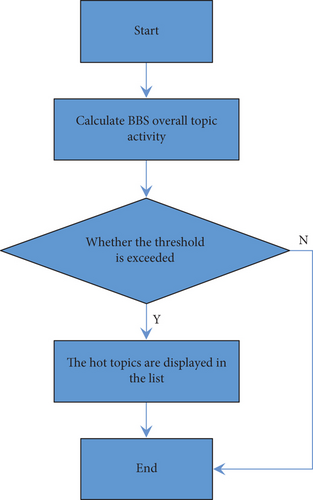
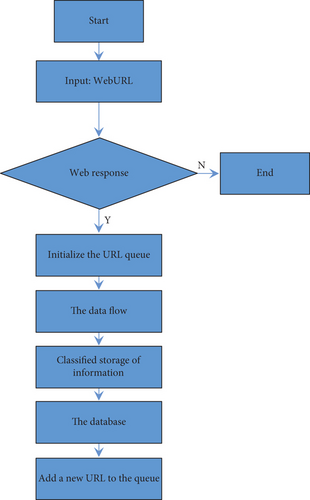
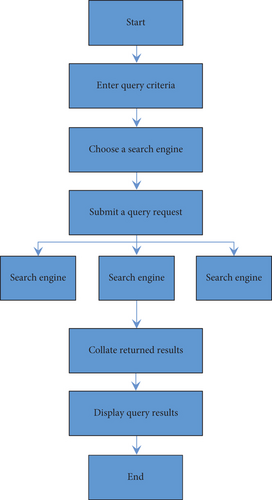
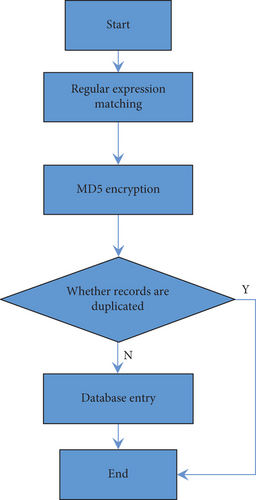
The collection system of media content in colleges and universities is mainly to be able to discover and collect new media content in time. The module also contains two submodules: metasearch capture module and results page and metadata download module. The former takes the returned URL and aggregates the keywords into the search set. The latter is responsible for extracting metadata of query results, downloading, and saving snapshots of result pages, and the data preprocessing module mainly cleans and standardizes data [25]. Data preprocessing module mainly includes the elimination of repeated data, feature module, and index module for the web page. In the analysis and mining module, the positive and negative information of the whole public opinion content is deeply mined, and there are three small modules mainly including text content, emotional content, and text similarity statistics.
5.2.4. System Deployment Diagram
- (1)
The front-end acquisition
- (2)
Safe isolation
- (3)
Back-end analysis and processing
- (4)
Feature extraction module
An article is composed of words, words, paragraphs, and chapters. In some articles, some features can be selected to represent the content of the article. As the words in the four parts are the most basic ideographic units, they can reflect the content characteristics of the text. If single words can show the characteristics of an article; then, they can represent some spatial vectors accordingly. In the process of feature extraction, all the words can be concentrated, and its principle is the expression method of the words in the article. It has a high similarity with a certain record of structured database. In a certain document, it can be said that feature vector can reflect the content characteristics of the document. Use multidimensional or one-dimensional web data to display text content and information, so that each content in the data table represents a feature and then forms a feature set. Each line can represent the functionality of the page, so the entire line is the statistics of the page. Based on the representation method of TF-IDF vector, two-dimensional data table is formed. The distinguishing values in dictionaries include feature set and column set. For each column, there may be hundreds of thousands of columns in the whole column set. Each line stores page word information corresponding to the feature set. For each word in the feature set, if the word does not form a set in the web interface, the value is 0. If the number of occurrences on the page is K, the final value is K. In this case, the construction of a two-dimensional table belongs to the statistics of the words in the collection of web pages. Also note that if the above method is used, it will represent the frequency of words on the page. Subset characteristics have been determined before mining, if the whole system reduces its dimension with DF > 50. In this case, we need to use rough set instead of attribute reduction.
5.3. System Test Module
This chapter mainly studies the source of college network public opinion in the whole system, carries on the statistics of the emotional tendency, and also carries on the experimental research for the scope of the whole public opinion. After that, the web crawler was used to timely capture public opinion and repeatedly test the algorithm. Figure 13 shows the random capture of 500 web pages in five industries, including medical care, transportation, education, public security, and military. The above web pages are clearly divided into statistics, and statistics are made for the corresponding industry types. As can be seen from the following figure, the recall probability of these five industry categories is higher than 70%, and the recall rate is greater than 80%, among which F1 value is greater than 70%. For F1 values, you can categorically classify them as response classes. The overall effect of this kind of medical and military industry is better, and the overall classification of transportation and education industry has basically the same effect. The overall effect of public security is relatively low, and the final reason is related to the data of training samples collected. The training sample content of public security can be adjusted again, so as to confirm the more suitable initial clustering center and confirm the accuracy of clustering again.
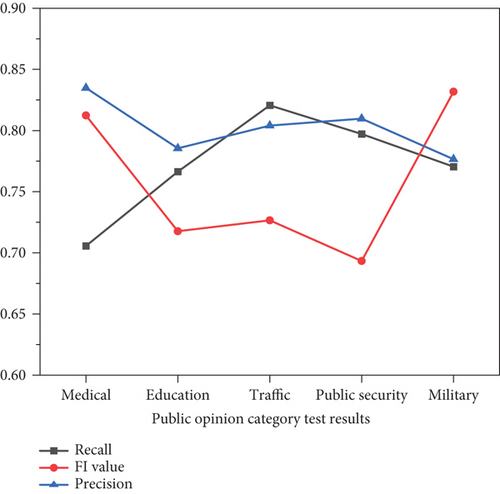
In order to analyze and verify the public opinion of the search system and determine its performance, Figure 14 clearly presents the classification based on the number of pages and text of the web page, so as to analyze the results and finally evaluate the corresponding accuracy rate and recall rate in terms of performance. Recall rate is also called weight check rate. In the figure above, random webpage extraction is carried out. It can be seen that with the increase of the number of webpage, the recall rate and accuracy rate of webpage classification also decrease. The reason is that the classification algorithm has not been considered in depth, and a large amount of web page information has been ignored, which is also a problem to be further studied and analyzed in the next step.
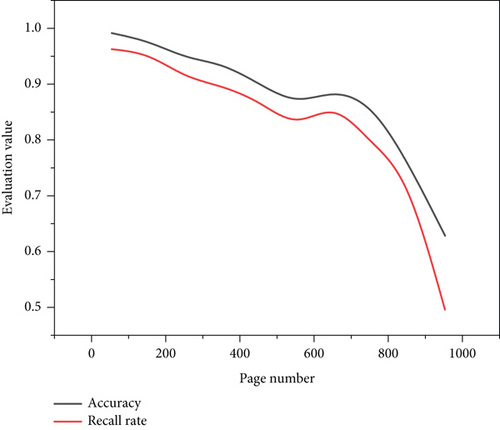
6. Conclusion
Times with the irreversible trend of rapid development, in people’s work and life, the Internet is playing an increasingly important role. Compared with traditional media, the Internet has more prominent features of convenience and timeliness. On the Internet, everyone can surf the Internet in an infinite virtual space. From the characteristics of the network, it has a certain concealment. Many people prefer to choose this mode when expressing their opinions, and the concept of online public opinion is derived from this background. Due to the rapid updating and upgrading of the Internet, online public opinion has gradually replaced other media as the main way for people to spread public opinions. This makes all countries attach more importance to online public opinion, and China attaches more importance to this issue. College departments focus on online public opinion factors to conduct research and take this as the basis for improving management methods. It can be judged that the trend of social public opinion is largely affected by online public opinion, so it is necessary to strengthen dynamic management of online public opinion and increase attention. Based on network public opinion, a content detection and analysis system for college campus network is established. Especially for colleges and universities, it is better to strengthen the campus network public opinion monitoring, content detection, and classification, to provide students with a healthier and more perfect campus network environment support.
Conflicts of Interest
The authors declare that they have no conflicts of interest.
Open Research
Data Availability
The dataset can be accessed upon request.




